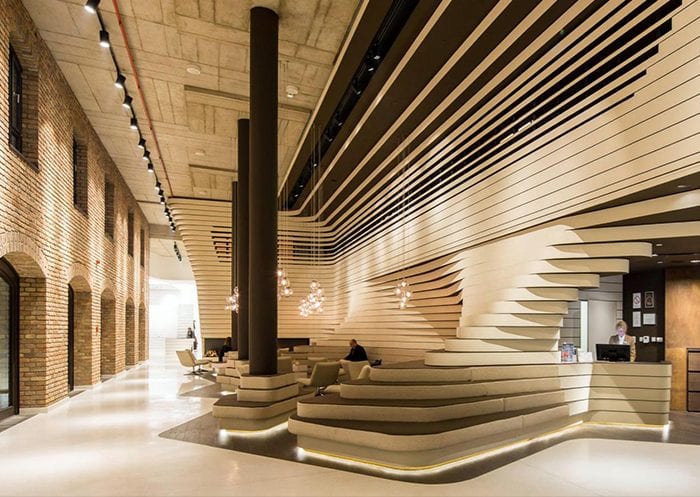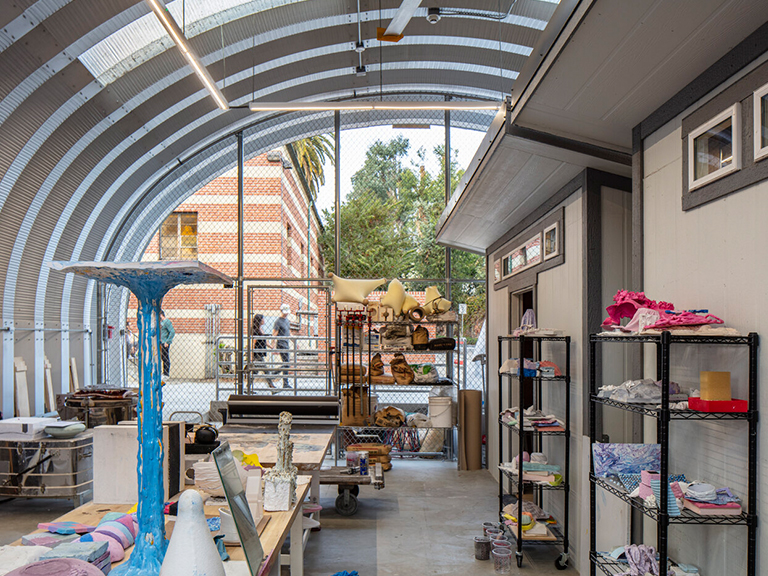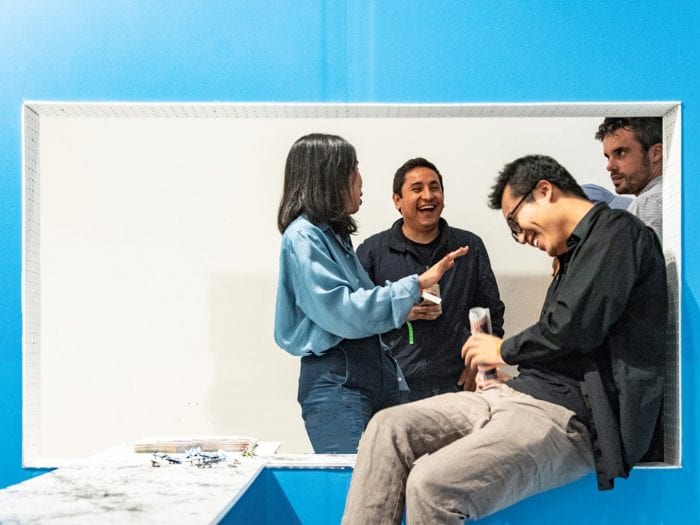School of Architecture
Interior Design
BFA in Interior Design (STEM Program)
Interior Design is the art of creating a memorable experience of the space that surrounds us. Woodbury’s School of Architecture offers a four-year Bachelor of Fine Arts (BFA) in Interior Design at its Los Angeles campus. Through small class sizes and individual attention, we foster close mentoring relationships between faculty, staff and students.
Interior Design is a STEM program. Learn more about STEM at Woodbury.
Apply Request Information Take a TourShaping the Future
Virtual and Augmented Reality
Students can engage the new interior spaces of gaming and both virtual and augmented reality. Take advantage of resources such as our VR lab and the course offerings of our Game Design and Applied Computer Science departments.
Interiors
Learn how to design commercial, residential and hospitality interiors for rooms and buildings. Design colors, materials, finishes, furniture, environmental graphics and more as you shape the experience of everyday life.
Fabrication & Materials
Design technologies and materials are changing rapidly, from 3D printing and CNC fabrication to the invention of new materials. Learn fabrication in wood and metal shops, a materials library, a digital fabrication lab, and a lighting lab.
Exhibition & Installation Design
Find out how to create exhibition and installation designs through new techniques in fabrication and curation. Take advantage of the Woodbury University Hollywood Outpost (WUHO), Julius Shulman Institute, and Wedge Gallery.
Woodbury’s BFA in Interior Design Officially Designated as STEM
All architecture and interior design programs at Woodbury have been designated as STEM degrees. The School of Architecture received approvals internally from the University Curriculum Committee and Office of Academic Affairs, and externally from WASC (WSCUC) and the Department of Homeland Security’s Student Exchange Visitor Program (SEVP).
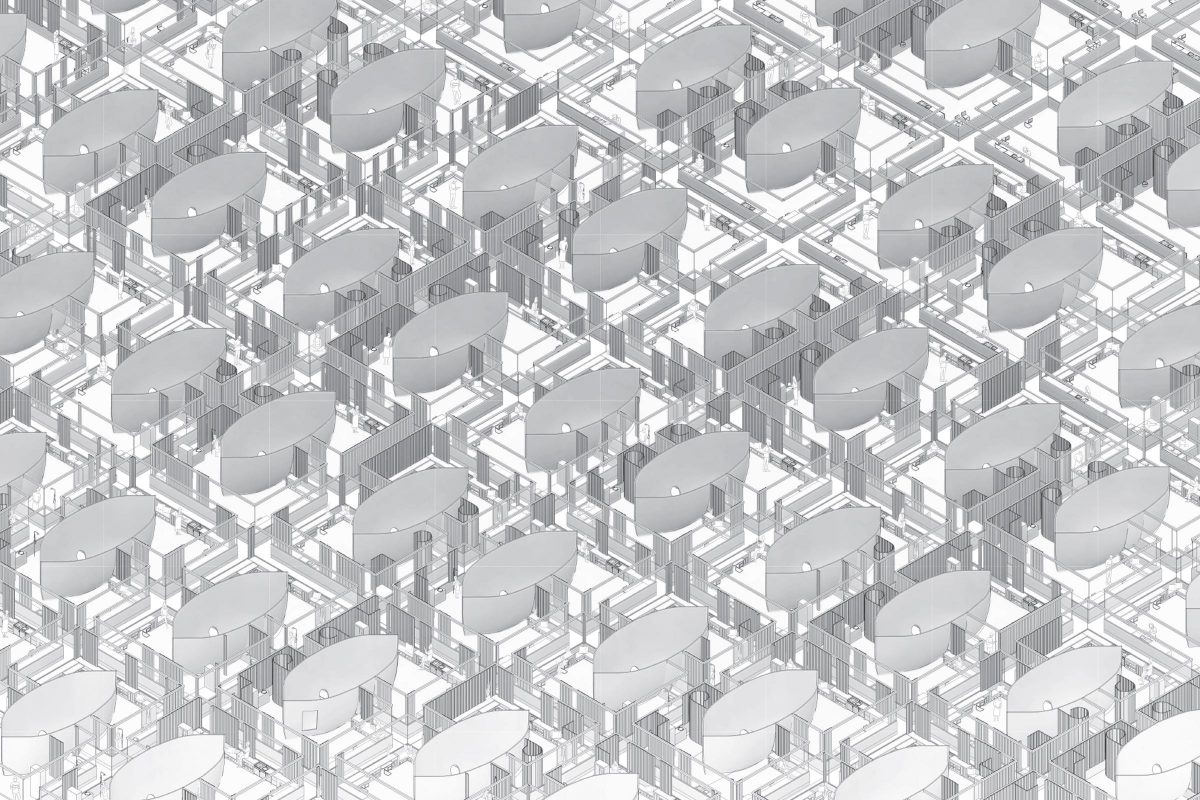
Faculty & Staff
Our internationally recognized and award-winning faculty work closely with students, teaching the skills required to push the limits of practice and explore disciplinary possibilities in both theoretical and professional arenas. Through individual attention, we foster close mentoring relationships between faculty, staff and students that extends to network opportunities after graduation.
Courses
The BFA program has 128 semester hours with 75 hours of major study, 45 hours in the liberal arts, and 9 hours of open electives. A portfolio review is required for students advancing from second-year studios into the upper-division studios. Students are also required to complete 128 hours of work experience. Explore the course catalog and program worksheet, and find out about transfer articulations here.
Internships & Careers
The BFA program creates a foundation of knowledge and skills that students will use in their professional lives. All undergraduate students are required to complete work experience in their discipline or allied profession as a degree requirement. Visit the School of Architecture Career Services page for more information about the services offered by our Career and Outreach staff.
Woodbury Prize
Tuition Scholarships
We provide transfer students with an incredible opportunity to reduce their educational expenses through the Woodbury Prize scholarship. This scholarship covers $5,000.00 in tuition fees for the entirety of their enrollment in our Architecture (BArch) and Interior Design (BFA) undergraduate programs. As a transfer student, you are automatically considered for the Woodbury Prize upon acceptance into our programs. To be eligible, you must have a GPA of 3.0 or above and possess a design portfolio. We have previously awarded scholarships to students transferring from esteemed institutions such as Pasadena City College, Glendale Community College, College of the Canyons, ELAC, and many other community colleges.
Our dedicated faculty members are available to review portfolios and offer guidance to prospective students. Whether you have already applied or not, we encourage you to contact Branka Olson, the program chair, at [email protected] to learn more about our scholarships and to have your portfolio reviewed. We are committed to supporting your academic journey and making it more affordable.
Student Success
Woodbury School of Architecture offers a four-year Bachelor of Fine Arts in Interior Design (BFA) at its Burbank campus. The program provides students with the analytical, design, and technical skills necessary for success in the interior design professions. You will become part of a student community that includes recipients of prestigious awards such as:
2020
Ebell/Flint Scholarship: Lorena Perez
2019
Network for Hospitality Industry (NEWH) scholarship: Jordan Zhang
3rd Place at the Knoll Design Challenge: Jordan Zhang and Lorena Perez
Ebell/Flint Scholarship: Marta Huo
IIDA SoCal Design Charette winner: Anna Grubinski Ossyra
$30,000 Donghia Foundation Scholarship: Ryanne Hawkins
2018
$30,000 Donghia Foundation Scholarship: Christian Esparza
Network for Hospitality Industry (NEWH) scholarship: Justin Jakubisn
2017
Network for Hospitality Industry (NEWH) scholarship: Angela Perea
IDEC video competition: Shahad Almazroa, Genesis Li, and Silviya Zhivkova
Killefer Flammang Architects Scholarship presented by the Association for Women in Architecture Foundation: Silviya Zhivkova
2016
$30,000 Donghia Foundation Scholarship: Dominic Luna, Carlos Ramirez
Carnegie Mellon UDream Scholarship: Kayla Manio
SoCAl IIDA student design charrette: Odalis Guerrero-Hernandez
Network for Hospitality Industry (NEWH) scholarship: Jasper Liao and Maryam Laleh
San Fernando Valley Chapter AIA Fund Awards Scholarship: Jasper Liao and Sara Noei
2015
$30,000 Donghia Foundation Scholarship: Yumin Zheng
2014
$30,000 Donghia Foundation Scholarship: Kristen Dusold
Student Achievement
Woodbury’s Bachelor of Fine Arts in Interior Design professional degree develops the students’ individual design focus while providing the practical training and knowledge necessary to succeed as an interior design professional. Moreover, Woodbury faculty and administrators are aware of the challenges in completing a college education and, together with the student, work to achieve a timely graduation and a successful entry into practice.
It typically takes a full-time student, at approximately 15 credits per semester, four years to complete the degree program. Students with a GPA of 3.5 or better are given the option to fast-track their coursework and graduate in six semesters and two summer or three years.
Student Attrition and Retention
89% of students admitted in the fall of 2021 returned in the fall of 2022, resulting in 11% attrition.
Graduation Rates:
Of the freshman student cohort (not including transfers) that graduating in 2022, 89% graduated in 4 years or less.
Here are a few statistics drawn from a survey of the BFA Interior Design Class of 2022:
Acceptance into Graduate Programs:
8% of students who graduated in 2022 applied for graduate school, and 100% were accepted.
Job Placement Rates:
88% of students who graduated in 2022 are employed in interior design or an allied profession.
Recent graduates, including the Class of 2022, have held positions at the following firms: Gensler, SOM, Barbara Bestor, Rios Clementi Hale Studios, HLW International, StudioMA, Johnson Fain, Chu+Gooding Architects, Boulder Associates, ZGF, Clive-Wilkinson Architects, Elan Designs, Charmean Neithart Interiors, Wolcott Architecture | Interiors, Klawiter Interior Planning and Design, About:Space, Diana Wong Architecture + Interior Design, Casa Wasy Interior Design, HDR, Bown Studios, Greenmeme, and Disney.
Related fields that recent graduates are working in include art direction and set design, jewelry, furniture, and product design.
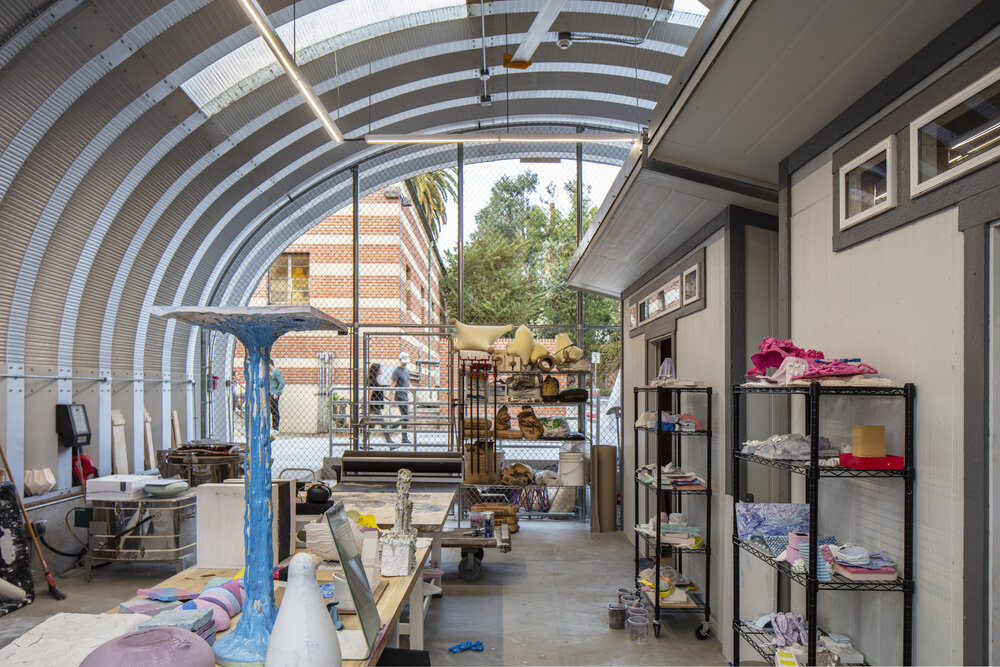
Facilities
Making Complex
The Burbank facility takes full advantage of the university’s academic offerings, student support services, comprehensive library, and residential campus life. At the same time, it offers specialized facilities including a wood shop, a metal shop, a materials resource library, a digital fabrication lab, a lighting lab, computing facilities, a render farm, and 24-hour access to studios, including a 15,000-square foot studio building.
Intelligent Lighting Laboratory
The Intelligent Lighting Laboratory allows the students to simulate lighting scenarios and explore through hands-on experience the effects of light on materials and space. It allows them to question the status quo of lighting design and to develop innovative ways of using lighting in architectural spaces. During their coursework new technologies are tested and the equipment and facilities help with the investigation of new ideas. Experiments investigate the impacts of these applications on both the experience of human users of architecture and energy consumption.
Materials Resource Library
The Materials Resource Library holds a large collection of physical samples and online resources, including a subscription to a comprehensive online material database called Material ConneXion. Samples represent a wide range of both standard interior finishes, and more experimental materials.
Advanced Material Testing Laboratory
The Advanced Material Testing Laboratory is equipped for its role as both a space for hands-on education and as a resource for cutting-edge research in the area of material science. It contains a range of equipment and technical support staff for the testing of material samples. Students can manipulate the interior space of the experimental environment with various materials and test the result to determine how color, surface textures, shade devices, lighting systems, and similar factors change the climate and perception of the space.
Accreditation
The Woodbury University Bachelor of Fine Arts in Interior Design (BFA-ID) professional degree program is accredited by the Council for Interior Design Accreditation (CIDA), and is designed to meet the California educational requirements for Interior Design certification in California.
Woodbury University’s BFA-ID program also prepares graduates to complete both the NCIDQ and the IDEX exams. Though our program meets the educational requirements in all 50 states, Washington DC, Puerto Rico, and Canadian provinces, students who wish to practice in a location outside of California may or may not have additional non-educational requirements to fulfill prior to applying for a certificate or registration status in that location.
Prior to enrollment, prospective students are strongly encouraged to review the Bachelor of Fine Arts in Interior Design (BFA-ID) professional licensure webpage to determine whether our BFA-ID program meets the educational requirements for certification/registration in the location(s) they wish to practice.
Woodbury University would like to assist prospective and current students with navigating this process. Please contact Admissions at [email protected] or 818-252-5221 for help.
For more information about accreditation, go to the About page.

